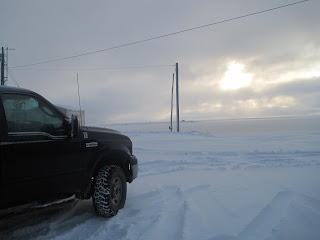When Dr. Grannas first asked if I wanted to venture into Alaska to continue my summer research, I thought, "Awesome! The arctic! I’ve never been there!" I was so excited to have a new experience and possibly even get to see some new culture. I had the stereotypical presumptions about what Alaska would be like: snow, glaciers, polar bears, and Eskimos. Boy, was I wrong.
Soon after I agreed to go on this trip, I learned that I wouldn’t be traveling to a common tourist city (Anchorage, Fairbanks...) but that I’d be spending a week in Barrow, Alaska. For those of you who aren’t familiar with Barrow, it’s about as far North as you can get, without actually being in the Arctic Ocean. Needless to say, I became a little less enthused at this thought, but still agreed to go.

When we arrived at the Barrow, Alaska airport I was immediately in shock. One – it was about 30° colder than Philadelphia at this time of year, and two- the airport was a single room consisting of a baggage claim belt, a metal detector/security station, and a few rows of chairs. Where had I landed that didn’t even have a proper airport!? At first glance, the town of Barrow seemed just as small and sparse, with wooden houses, metal "huts", a single grocery store, and a handful of restaurants. Little did I know that by the end of the week Barrow would grow on me.

Many people who visit Barrow might have the same thoughts and judgments that I first had on my arrival. A small, dreary town that was covered in snow and ice would not seem appealing to some. However, Barrow has its own kind of charm. The people living in this community rely on each other and help one another out in a way that most “down south” have forgotten how to do. This small town of about 4,000 people collectively contributes to each family’s food supply and general well being, ensuring that all will make it through the tough Alaskan winters with enough to eat and neighbors who truly care. When a crew catches a whale in Barrow, the meat is divided up evenly and distributed to each family. Never before had I experienced such a sense of community.

With respect to the town itself, Barrow has many hidden treasures that I was not anticipating to find. Restaurants like Pepe’s North of the Border serves awesome Mexican food… as well as Italian, American, and probably whatever else you are craving! The restaurant itself is a little Mexican oasis – yellow, red, and green decorations cover the walls and sombreros hang from the ceiling, and after eating there for the first time you receive your official "Arctic Circle Club: North of the Border" certificate. Osaka, a Japanese restaurant, serves some of the best sushi I have ever tasted, and a trip to the AC grocery store put in perspective for me how outrageous a simple gallon of milk is in Alaska - $10. Wow.

My trip to Barrow is an experience that I will never forget. The welcoming community and the Eskimo culture definitely broadened my horizons and made me step outside the small world of Villanova’s campus. I can honestly say that I was pleasantly surprised by this small Alaskan town and hope in the future that my research will bring me back again! :)










 His collection has garnered the attention of the Smithsonian ... they have wanted to borrow pieces for study, but he has a strict policy that nothing from his museum is sold (and offers for some pieces have been high), and nothing leaves the premises. He cherishes the items too much to risk having them lost or damaged. He has however let the experts set up camp at his house and several times they have spent a few days studying pieces on his back porch.
His collection has garnered the attention of the Smithsonian ... they have wanted to borrow pieces for study, but he has a strict policy that nothing from his museum is sold (and offers for some pieces have been high), and nothing leaves the premises. He cherishes the items too much to risk having them lost or damaged. He has however let the experts set up camp at his house and several times they have spent a few days studying pieces on his back porch.











 Not everyone needs fancy equipment ... see here the use of a run of the mill caulking gun for sample filtering. We draw water up into a syringe, then screw a filter onto the end. We push the water out of the syringe, through the filter, then into the collection bottle. Problem is, the particulate matter in the water clogs our filters rather easily, making it VERY difficult to get the water through with just your hands ... so a caulking gun adds the extra "oomph" we need to get the job done.
Not everyone needs fancy equipment ... see here the use of a run of the mill caulking gun for sample filtering. We draw water up into a syringe, then screw a filter onto the end. We push the water out of the syringe, through the filter, then into the collection bottle. Problem is, the particulate matter in the water clogs our filters rather easily, making it VERY difficult to get the water through with just your hands ... so a caulking gun adds the extra "oomph" we need to get the job done. 



